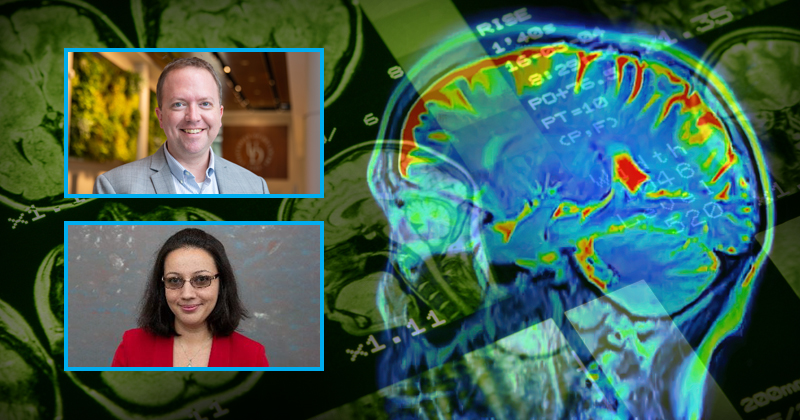
Category: Interdisciplinary Neuroscience

UD Neuroscience Symposium Celebrates Interdisciplinarity
February 28, 2024 Written by Lisa Walenceus | Graphic Illustration by Cindy Dolan
Our brains are staggeringly complex organs that govern our thoughts, memories, emotions, sensory experiences, communications and movements. They also regulate every process within our bodies. Recently, the Interdisciplinary Neuroscience Symposium at the University of Delaware provided a platform for faculty, graduate students and prospective students to delve into the panorama of neuroscience research being conducted at UD. The goal of this research? To unravel the mysteries of these complex structures, which consist of approximately 86 billion neurons, 85 billion other cells and an astonishing 100 trillion connections.
The event’s keynote speakers, faculty presentations and graduate student posters highlighted research that spanned brain structure and function from development to degeneration and included diverse disorders and diseases, demonstrating why neuroscience is a compelling model for scientific discovery.
“Through these talks and posters, we see the tremendous breadth and diversity of what can fall under the umbrella of what is neuroscience,” said William Kenkel, assistant professor in the Department of Psychological and Brain Sciences. “On the one hand, you have the engineers doing the ‘brain-jiggling’ and measuring with magnets, and then you also have people doing research with humans, or rodents or fruit flies.”
“However, you also see themes — like reproduction, for example,” he continued. “Lisha Shao from the Department of Biological Sciences talked about it, Jaclyn Schwarz from my department talked about it, and I talked about it too. It’s great to see our colleagues’ work and to find those throughlines: Those are potential collaborations.”
Curtis Johnson, associate professor of biomedical engineering in the College of Engineering, was one of two keynote speakers to address the role of the Center for Biomedical and Brain Imaging and its cutting-edge MRI in advancing neuroscience. For him, weaving together insights and perspectives from different scientific domains is what drives innovation.
“Our research is on brain tissue mechanical properties — what the brain would feel like if you were to squeeze it—and we learn a lot about brain tissue function, structure and health from virtually squeezing it with the MRI screener,” Johnson explained. “It’s important for my students to see people from different disciplines come at a problem just ... differently. And not necessarily trying to answer the same problem — their training leads them down a different path. So, hearing different points of view knocks my students right off their axis. Then, we can find common ground.
“Everything that I presented today came from people interpreting what I said to them differently than I did, and then we went down a new path together.”
For keynote speaker Roxana Burciu, assistant professor in kinesiology and applied physiology in the College of Health Sciences, the very nature of what she studies requires interdisciplinarity to really understand the problem.
“In our research on Parkinson’s disease,” she said, “We use MRI to understand how brain changes lead to difficulties with everyday movements for people with the disease. Because there’s considerable variability in symptoms and their progression stemming from multiple causes, we need a multifaceted approach that transcends traditional disciplinary boundaries.
“Parkinson’s symptoms can be due to genetic predisposition, environmental factors or underlying neurobiological mechanisms — each of these demands a unique investigative lens.”
The symposium reflected the ethos of UD’s interdisciplinary neuroscience program, said Andre Ma, president of the Neuroscience Graduate Student Association. “Working in one field, you can find yourself living in a bubble, so having a program like this, gathering people together so that we exchange ideas and bounce ideas off one another, that’s what pushes our science forward. That’s what it takes to discover something important.”
Bridget Armstrong found the day of lively presentations and discussions inspiring. “As a prospective student, seeing the integrative, interdisciplinary aspects of the research here is exciting. I just see possibility and opportunity to branch out and not be boxed into one field of study, and there seems to be support for collaborating with a large and diverse group of researchers.”
A gathering of faculty and graduate students across three UD colleges
In addition to the keynote addresses by Johnson and Burciu, the 75 symposium attendees were welcomed by John Jeka, program director for the interdisciplinary neuroscience program and officers of the Neuroscience Graduate Student Association, Devashish Pande, Andre Ma and Ian Smith.
Faculty from the College of Arts and Sciences, the College of Health Sciences and the College of Engineering gave research presentations:
- Wiliam Kenkel: “First Impressions: The Importance of Oxytocin at Birth”
- Lisha Shao: “Dissecting the reward pathways in a tiny brain”
- Jaclyn Schwarz: “How does immune activation impact the brain during sensitive periods of the life span?”
- Ho Ming Chow: “The neurobiology of stuttering”
- Anna Klintsova: “Brain plasticity in health and disease”
- Sayako Earle: “Memory and perception of speech”
- Maryam Vaziri-Pashkam: “Visual processing for interacting with objects and people”
Fourteen graduate students presented posters at the event. Philip Gable, graduate director of the interdisciplinary neuroscience program, gave awards to two winning presenters:
- Tim McCoy: “The force of craving: Approach movements relate to materialized P3 amplitudes and sensation seeking”
- Ian Smith: “Third-trimester binge alcohol exposure alters executive functioning-related behavior and neuronal activation in the thalamic nucleus reuniens”
UD’s interdisciplinary neuroscience program has a unique structure that fosters collaboration across fields and equips students with a diverse set of skills. To learn more, visit udel.edu/grad/ing.
